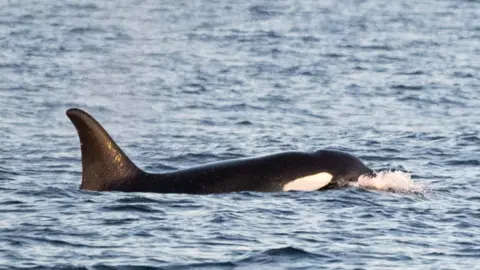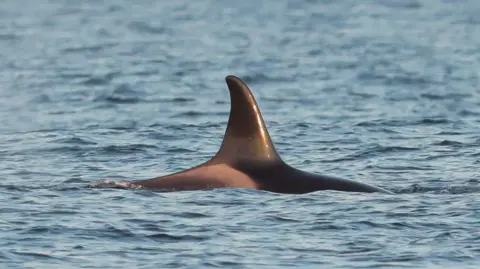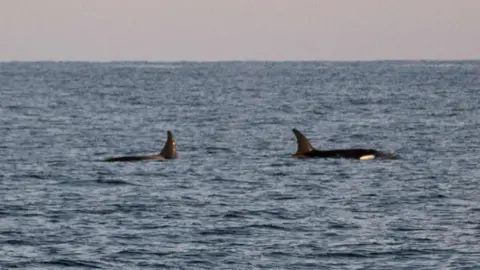Iberian orca seen for first time in Cornish waters
 Isaac Ogden
Isaac OgdenWildlife experts have confirmed the first ever sighting of orcas from Iberia in Cornish waters.
The two orcas were seen by Joe Pender as he conducted a seabird survey near St Agnes, the Isles of Scilly on Wednesday evening.
Rebecca Allen of the Cornwall Wildlife Trust said it was the first time members of the pod, which inhabit the Straits of Gibraltar in winter, had been recorded off Cornwall and the Isles of Scilly.
Sarah Matthews of Dolphin Zone which identified the mammals said the pair was thought to be "the last of their very, very tiny family".
 Joe Pender
Joe PenderJoe Pender was the skipper aboard the Scilly Pelagics seabird survey who saw the orcas, which are the largest members of the dolphin family.
He told the BBC he had spotted some fins about a mile away near Bishop Rock and as he drew nearer he had realised they did not belong to common dolphins as they were "far too big".
"As we got closer, we realised they were two orcas together," he said.
Mr Pender said everyone on the boat had been "ecstatic" as they spent about half an hour observing the mammals.
He said: "I've seen an orca very distantly some 25 years ago and that's the only one I've ever seen.
"They're really rare, it's one thing we really didn't expect to see here."
He said it was possible the pair had been in the area for a few days and a fisherman thought he had seen the pair earlier in the week.
Mr Pender added: "There's been a few seals coming up in the nets having been eaten, it's possible they [the orcas] may be the culprits."
 Isaac Ogden
Isaac OgdenMs Matthews said she had initially thought the pair could be two bull orcas based in Scotland known as John Coe and Aquarius, which circumnavigated the UK in 2021.
On closer inspection of the photos she realised the pair seen near St Agnes were female and since the sea surface temperature was high at the moment, she checked the 80-page Iberian orca catalogue.
She identified one of the pair as C002, Freyja, an Iberian orca but from a tiny pod.
Ms Matthews said: "There used to be three in the pod but now there are only two.
"She is a female and she is always seen with this other one, although we need to get further identification on the second whale, we think she may be C001.
"She is somehow distinct from the other Iberian orcas and they really are a mystery."
'Last of their family'
Ms Matthews said most of the Iberian orcas fed on tuna but this pair ate small fish.
"They are quite an elusive pair that appears to pop up randomly in different places," she added.
She said they had never been seen either with calves or other orcas.
"They are possibly the last of their eco-type or of their very, very small family," she said.
"We know they are in their 20s at least so hopefully we'll have them for some time, but they really are likely to be the last of their current family."
 Joe Pender
Joe PenderMs Allen said the Environmental Records Office for Cornwall and the Isles of Scilly had recorded "so many changes in the type of species we see".
She said: "We're seeing more tuna, common dolphin, humpback whales and there's been a big boom in the octopus population.
"This year seems to have been a notable year for lots of different species and it really feels there's been a change that's driving this.
"We don't understand what this might be but it's probably linked to warming seas and pushing populations of species further north."
"As much as it's really exciting, it's a little bit of a concern," she added.
Mr Pender agreed: "We're seeing a lot more humpbacks, fin whale and blue fin tuna - everything's on the move."
Follow BBC Cornwall on X, Facebook and Instagram. Send your story ideas to [email protected].
